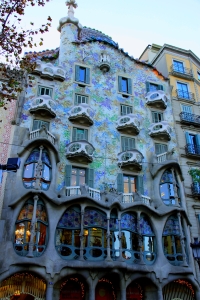As an artist in my own right, I think about leaving my legacy behind in my writing, music, and films. So it is with a heavy heart that I learned about the Catalan artist and architect Antoni Gaudi (God’s Architect) who passed away tragically prior to completing work on his most famous of works: the Basílica i Temple Expiatori de la Sagrada Família, or la Sagrada Familia, for short. His magnum opus.

Gaudi’s thumbprint can be seen across the city of Barcelona from the basilica to Casa Batllo and to the works of his financier Palau Guell and Park Guell. Though, the structures do not dominate the entire skyline. During his life, he designed 19 buildings in Barcelona alone. His art defies traditional architecture and his style is often described as neo-gothic, moderniste, and even Oriental. He rarely drew up plans, choosing instead to mold three-dimensional models.
Perhaps one of the most interesting and appealing aspects of this designer’s method is how he used his creations to tell stories. Gaudi put relentless thought and consideration into each and every element of his design from the materials used to the way in which they would be used.
From the outside, the basilica facades tell the story of the birth and death of Jesus (on each side respectively). This can be seen in the statues that decorate the area surrounding the doors. The Nativity Facade faces the sunrise while the Passion Facade faces sunset. By the time the church is finally completed, around 2026, there will be a total of 18 spires each representing a different person (12 for the disciples, 4 for the evangelists, 1 for the Virgin Mary, and 1 for Jesus). Currently, only 8 have been finished.
The exterior isn’t much to look at from a style standpoint, however, the interior will blow you away. The entire apse is designed as a geometric hyperboloid (I had no idea what this was, but it looks cool as hell). The pillars that hold up the entire structure are designed to look like trees (redwoods if you ask me) adding a natural element. The roof is so high, it appears these ‘trees’ reach up to heaven itself.
I suppose the fact that Gaudi is so well appreciated so many years after his death fills me with hope for my own creative works. Even if I end up destitute prior to my death, there is always that chance that my books are discovered and downloaded on Amazon.com in the next few hundred years.
Hasta La Proxima…
-Justin



